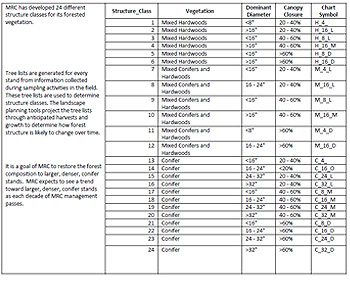Only 3% of Trees 24" Diameter or Greater: An Allegation
(Last Revised 7/5/2002)
The statistics quoting that only 3% of MRC lands are in trees 24" or greater is misleading - it is based on a "Quadratic Mean Diameter" average to determine habitat classes which is not indicative of the diameter distribution of trees in the forests. MRC determines forest structure using Landscape Planning. The forest structure classes determined from field sampling information indicate that approximately 8% of MRC lands have forest conditions with trees 24" or greater as the dominant vegetation on the land. Trees 24" and greater are found distributed throughout other forested stands on MRC lands. The facts are that MRC has a total conifer (redwood and Doug-fir) inventory of 2.4 Billion board feet, of which 1.1 Billion board feet are found in trees with greater than 24" diameter. Regardless, MRC is harvesting in such a manner to improve the distribution of larger trees, especially redwood, across the landscape.
Forest Structure Classes
Forest structural conditions have strong associations with wildlife use. Mendocino Redwood Company's landscape planning tools include a component that classifies forest vegetation into groupings or classes of forest structure. Forest structure classes are based on:
- Species dominance
- Size dominance
- Density of the forest
Mendocino Redwood Company developed this system for determining structure classes in order to understand both the current condition of the forest and changes to forest structure resulting from forest growth and harvesting activities. The system was developed as an alternative to the California WHR (Wildlife Habitats Relationship) model because the WHR system was developed for even-aged management, where trees in a forest stand are very close to the same size and age. MRC manages its forest with uneven age harvesting. This means that there are trees from more than one age and size group in forested stands at all times. WHR determines the size of the forest stand utilizing an average. Averaging works well for forested stands where the distribution of tree sizes within a stand is minimal. It does not describe the condition of a forest with a wide distribution of sizes, as in uneven age management.
